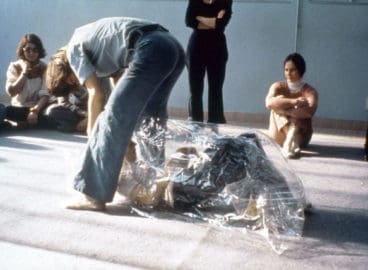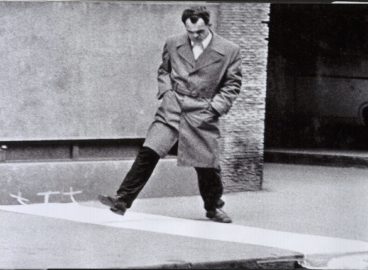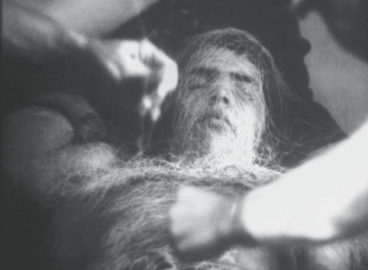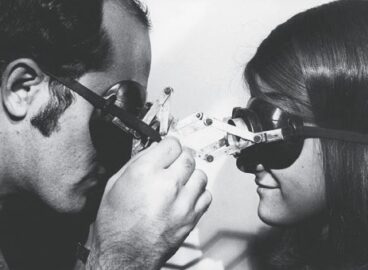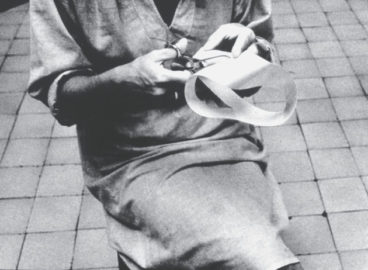Professor, author, and curator André Lepecki follows Brazilian artist Lygia Clark’s transition from visual arts to performance art although she refused that label. Part two of this essay discusses her fight against institutions and her works’ invitation to participate beyond the strict boundaries of the artist as the sole creator.
In addition to Lepecki’s essay, you can access installation views and the press release through MoMA’s online exhibition history archive here.

Between 1972 and 1976, Clark developed the ideas embodied in the Arquiteturas biológicas in a weekly seminar on “gestural expressivity” that she had been invited to teach in the recently established fine-arts faculty of the Sorbonne’s Centre St. Charles. She and her students deepened the notion of collective creation explored in O corpo é a casa, expanding it into sets of propositions called Fantasmática do Corpo (Fantasmatics of the body) and Corpo Coletivo (Collective body).1Of these propositions, Baba antropofágica(Anthropophagic slobber, 1973) is among the most impressive of Clark’s psychophysical experiments at the Sorbonne, and certainly one of the most visually beautiful. See Eleonora Fabião’s essay, “The Making of a Body: Lygia Clark’s Anthropophagic Slobber,” also in the catalog for the exhibition, Lygia Clark: The Abandonment Of Art, 1948-1988, at the Museum of Modern Art, May 10-August 24, 2010. Experimental, collective, and participatory, Clark’s seminars were aimed not at creating artworks or performances but, in her words, at creating a “living culture, in which the artist cuts himself off from the traditional base and gives the body its central position again. This is a living form of production for this productive society. . . . To get there, one needs to make a disinstitutionalization, both of the body as of all concrete relationships.”2Clark, untitled text, n.d. (c. 1974?), in Lygia Clark(Barcelona), p. 301.
We must remember two aspects in particular of the “disinstitutionalization” to which Clark refers. It is not just a matter of institutional critique, so important in such performance works of the late 1960s and early ’70s as Mierle Ukeles’s Maintenance Art Process (1968–72) and Hans Hacke’s MoMA Poll (1970). In fact Clark doubted the effectiveness of this kind of critique. In a taped conversation at the Museu do Imagem e do Som in Rio de Janeiro, on September 14, 1979, she told yet another story of refusing a curator’s invitation, this time to show at the Musée d’Art Moderne de la Ville de Paris. According to Clark, the curator had urged her to reconsider, given that several other artists engaged in what the curator called a “critique of the museum” had accepted the invitation so as to “work against the museum.” Clark said she had replied, “Do not think I am so naïve as to believe that these artists will destroy the museum. It is you who have devoured the artists, and integrated them. I will not take part in this.”3Clark, interview of September 14, 1979, Museu da Imagem e do Som, Rio de Janeiro. Audio file, Associação Cultural “O Mundo de Lygia Clark.” Author’s trans.
For Clark, institutional critique was not enough for disinstitutionalization. A deeper politics was required, predicated on two intertwined notions: the perception that our bodies had been captured by various institutional forces and “sad affects” (in Spinoza’s phrase) that robbed it of life; and the belief that the idea of artistic creation had to be replaced with that of collective work. What mattered was collective production of new experiential corporealities, new intersubjective relationships, as fundamental actions leading to a fuller way of living life. These two ideas led to a third: a critique of art as communication, and consequently an escape from semiotics. Clark wrote in her text on disinstitutionalization, “From this comes much more than communication. There is a geometry in all fantastic creations, which are a continuous intersubjective exchange” (emphasis mine).4Ibid.
This is Clark’s deeper point—that “creating has always been something different from communicating,” as Gilles Deleuze was to remark. “The key thing may be to create vacuoles of noncommunication, circuit breakers, so we can elude control.”5Gilles Deleuze, “Control and Becoming,” in Negotiations: 1972–1990, trans. Joughin Martin (New York: Columbia University Press, 1995), p. 175. For Clark, intersubjective exchange creates above all not communication but a processual, immanent, and unfolding geometry within which the collective and anonymous production of “circuit-breakers” against micro-fascist control (including micro-fascist self-control) can take place. This is the organic, affective geometry that Clark described as early as her 1959 “Letter to Mondrian.”6Clark, “Letter to Mondrian,” May 1959, in Lygia Clark (Barcelona), p. 114. It is the geometry that she discovered in 1954 in what she called “the organic line,” a vacuole she inserted in the canvas surface, and from which another concept, another vacuole central to her practice, would erupt in 1959: the vazio-pleno (empty-full). Suely Rolnik defines Clark’s existential, aesthetic, non-Euclidean geometry of the empty-full as “the experience of the vibrating body at the moment in which the exhaustion of a cartography is processed, when the silent incubation of a new reality of feeling is under way.”7Rolnik, “Molding a Contemporary Soul,” p. 67.

Clark’s understanding of geometry as “continuous intersubjective exchange” reorganizes everything: language, body, art, creation, sexuality, imagination, objects, modes of being a collective, modes of being singular. This geometry, as topological as it was affective, delineated a rigorous experimental quest for nothing less than a new organicity and its concomitant new subjectivity. If Clark called her works between 1968 and 1976 “a preparation for life,”8Clark, quoted in Brett, “Lygia Clark: Six Cells,” in Lygia Clark (Barcelona), p. 20. it is clear that her affective geometry corresponded to a diagrammatic approach to both life and art—indeed Paulo Herkenhoff has called works of hers “diagrams for social coexistence.”9Herkenhoff, quoted in Rolnik, De l’oeuvre à l’événement, p. 85. Author’s trans. See Brian Massumi, Semblance and Event (Cambridge, Mass.: The MIT Press, 2011). Participation, corporeality, fragility, precariousness, ephemerality, the politics of the collective: these crucial components of performance art, Happenings, and body art all undertake a different “geometry” in Clark’s propositions.
We can now understand how, caught in the vital budding moment of her experiments with her students, and realizing that “disinstitutionalization” must implicate the destruction of the idea of the artist as creator and that an affective geometry of expression must imply deep collective participation, Clark could only allow the episode with the curator that Bois witnessed in 1973 to arrive at one outcome: she could only reject both the classification of her work as body art and the exhibition format itself. Her resistance to being captured by the institution and categories of performance was not merely the idiosyncratic response of a supposedly difficult artist. Rather, it suggests a lucid premonition: it is as if Clark knew that in the decades to come, performance would become a dominant paradigm, to be devoured and digested by institutional power. She had to anticipate and resist all the future dead ends, misunderstandings, and reinstitutionalizations such dominance would entail.
A few months after this episode with the curator, Clark felt compelled to clarify her position on the distinction between her work and performance art. In a text published in 1975 but probably written in 1974, she identified works of the kind she felt had to be rejected in the performance and body art of the period: Pane’s action The Conditioning, first action of Self-Portraits (1973), in which the French artist lay on a metal surface with dozens of lit candles beneath it, her pain from the heat visible to the audience; Gino de Dominicis’s Seconda soluzione di immortalità (L’Universo e immobile) (Second solution of immortality [the universe is immobile], 1972), in which the Italian artist hired a young man with Down syndrome to wear a sign around his neck bearing the work’s title; and finally a work by a male American artist that Clark describes somewhat unclearly—probably Dennis Oppenheim’s Parallel Stress (1970), in which the artist bridged two sets of cement blocks a few feet apart with his body.10Clark, “On the Suppression of the Object (Notes),” 1975, in Lygia Clark (Barcelona), p. 264. Clark named Gina Pane but not the other two artists. Brett, in a videotaped interview with Rolnik in 2004, revealed that it was he who had shown Clark a photograph of “an artist suspended between two blocks,” and that although he could no longer recall who that artist was, he thought it could have been Dennis Oppenheim, whose Parallel Stress is consistent with his own description and somewhat consistent with Clark’s. Arquivo para uma obra-acontecimento, one of a fifty-three-DVD collection, directed by Rolnik, produced by SESC and Cinemateca brasileira (2003–10); available online at www.bcc.org.br/arquivo-para-uma-obra-acontecimento. Although Bruce McLean is not American (as Clark had specified), another possibility is his Pose Work for Plinths (1971), on which Brett has written, and which may both correspond better to Brett’s description and lead us more directly to Clark’s conclusion about the artist “who still needs an object, even if he is the object, in order to deny it.” Clark, “On the Suppression of the Object (Notes),” p. 265. What matters in these examples is less who the artists were but the fact that Clark perceived their very different actions as profoundly misguided on three levels: aesthetically, the works were unable to overcome the “suppression of the object” that Clark had advocated since Caminhando, and made the performance artist or body artist him- or herself the new object of contemplation; ethically, they resulted from a “corruption which might be called modism,” and the performance artist merely reproduced the expectations of the market;11Ibid. and psychologically, they offered no more than a voyeuristic display of personal fantasies. What troubled Clark most, however, was what she called a “regressive attitude,” pathological not only at the psychological level but at the art-historical one: “as the artist becomes the object, he does not accept the still transferred poetic loss, on the contrary, it is still the body which becomes the object, but there is no qualitative leap, it is a regressive attitude” . . . “a romantic attitude by the artist who still needs an object, even if he is the object, in order to deny it.”12Ibid.
For Clark, the most objectionable aspect of performance art and body art was their assimilation of the body of the artist with the body of the work, a convergence of author function and artwork in the figure of the artist’s body that gave to the artist’s presence a highly problematic primacy. She saw, and found intolerable, how a system of authorial hyperpresence (particularly in body art) risked being inflected with a kind of martyrology. We may think here not only of Pane but of artists active in the late 1960s and 1970s such as Marina Abramović, Vito Acconci, Otto Muehl, and Chris Burden, to name just a few. As unfair as this critique of their works might be, Clark remained faithful to her positions until the end of her life—not without justification, given the current glorification of selected performance artists’ (often martyrological, almost always objectified) presence in museums, galleries, and international biennials.
The reconcretion of the work of art as a work of life, which Clark announced as early as 1956 in a lecture at the Escola Nacional de Arquitetura in her native city of Belo Horizonte (two years before Allan Kaprow announced a “new concrete art” in which “all of life” would be at hand as material),13Allan Kaprow, “The Legacy of Jackson Pollock,” 1958, in Essays on the Blurring of Art and Life, ed. Jeff Kelley (Berkeley and Los Angeles: University of California Press, 2003), p. 9. On the many, quite interesting parallels between Clark and Kaprow see Laura Cull, Theatres of Immanence: Deleuze and the Ethics of Performance (London: Palgrave Macmillan, 2012), pp. 145–77. required a double dissolution, a double becoming-imperceptible: “the work of art once again takes on the sense of anonymity” and “the artist thus abdicates something of his personality.”14Clark, untitled text, n.d., in Lygia Clark (Barcelona), p. 157. Clark, “On the Magic of the Object,” in ibid., p. 154. There is more than mere disagreement, then, on whether or not the terms “performance art,” “body art,” and “Happenings” conceptually or semantically express the essence of Clark’s work; it is a question of a radically different vision of art, in which what is at stake is not Kaprow’s “blurring of art and life” but a dissolution of the central figure that creates the binary: the artist as exceptional object of praise.
In this dissolution it is the artist him- or herself who vanishes. The participants in Clark’s propositions do not exactly “take part” in a performance exterior to them, or participate in a work authored by another. Rather, they incorporate propositions, inevitably transforming them, inventing them, refusing them, altering them—until finally they are incorporated into a new way of living life. The becoming-imperceptible of the artwork accompanies an anti-epideictic understanding of the artist’s presence and subjectivity, but this understanding must also be extended to the participant, in what Annette Leddy (in a different context) called a “person-eliminative approach” to art.15Annette Leddy, “Intimate: The Allan Kaprow papers,” in Allan Kaprow: Art as Life, eds. Eva Meyer-Hermann, Andrew Perchuk, and Stephanie Rosenthal (Los Angeles: Getty Publications, 2008), p. 43. Anticipating Roberto Esposito’s insight that “the person is not to be conceived of as the only form within which life is destined to flow,” Clark theorized and practiced a positive understanding of the impersonal.16Roberto Esposito, Third Person: Politics of Life and Philosophy of the Impersonal, trans. Zakiya Hanafi (Cambridge: Polity Press, 2012), p. 140. Her own propositions at the Sorbonne were aimed at a multiplication of anonymous propositions—rather than at the perpetuation of a system constantly (re)producing ever more artists and ever more art objects. Clark narrates how at the Sorbonne,
In the first three months I would give [the students] my sensorial objects. Three months later, they started making their own activities and propositions. I have several examples of works of that period that I did not invent or create. . . . Another curious thing: at the beginning the students would always communicate to me or through me. After a month, they did not even look at me anymore, and discussed the work among themselves. I was an outcast element.17Clark, interview of September 14, 1979, Museu da Imagem e do Som.
This is the second section of an essay by André Lepecki on the Brazilian artist Lygia Clark, excerpted from the exhibition catalog Lygia Clark: The Abandonment Of Art, 1948-1988, available at the MoMA bookstore. Read the first section here and the third and final section here.
- 1Of these propositions, Baba antropofágica(Anthropophagic slobber, 1973) is among the most impressive of Clark’s psychophysical experiments at the Sorbonne, and certainly one of the most visually beautiful. See Eleonora Fabião’s essay, “The Making of a Body: Lygia Clark’s Anthropophagic Slobber,” also in the catalog for the exhibition, Lygia Clark: The Abandonment Of Art, 1948-1988, at the Museum of Modern Art, May 10-August 24, 2010.
- 2Clark, untitled text, n.d. (c. 1974?), in Lygia Clark(Barcelona), p. 301.
- 3Clark, interview of September 14, 1979, Museu da Imagem e do Som, Rio de Janeiro. Audio file, Associação Cultural “O Mundo de Lygia Clark.” Author’s trans.
- 4Ibid.
- 5Gilles Deleuze, “Control and Becoming,” in Negotiations: 1972–1990, trans. Joughin Martin (New York: Columbia University Press, 1995), p. 175.
- 6Clark, “Letter to Mondrian,” May 1959, in Lygia Clark (Barcelona), p. 114.
- 7Rolnik, “Molding a Contemporary Soul,” p. 67.
- 8Clark, quoted in Brett, “Lygia Clark: Six Cells,” in Lygia Clark (Barcelona), p. 20.
- 9Herkenhoff, quoted in Rolnik, De l’oeuvre à l’événement, p. 85. Author’s trans. See Brian Massumi, Semblance and Event (Cambridge, Mass.: The MIT Press, 2011).
- 10Clark, “On the Suppression of the Object (Notes),” 1975, in Lygia Clark (Barcelona), p. 264. Clark named Gina Pane but not the other two artists. Brett, in a videotaped interview with Rolnik in 2004, revealed that it was he who had shown Clark a photograph of “an artist suspended between two blocks,” and that although he could no longer recall who that artist was, he thought it could have been Dennis Oppenheim, whose Parallel Stress is consistent with his own description and somewhat consistent with Clark’s. Arquivo para uma obra-acontecimento, one of a fifty-three-DVD collection, directed by Rolnik, produced by SESC and Cinemateca brasileira (2003–10); available online at www.bcc.org.br/arquivo-para-uma-obra-acontecimento. Although Bruce McLean is not American (as Clark had specified), another possibility is his Pose Work for Plinths (1971), on which Brett has written, and which may both correspond better to Brett’s description and lead us more directly to Clark’s conclusion about the artist “who still needs an object, even if he is the object, in order to deny it.” Clark, “On the Suppression of the Object (Notes),” p. 265.
- 11Ibid.
- 12Ibid.
- 13Allan Kaprow, “The Legacy of Jackson Pollock,” 1958, in Essays on the Blurring of Art and Life, ed. Jeff Kelley (Berkeley and Los Angeles: University of California Press, 2003), p. 9. On the many, quite interesting parallels between Clark and Kaprow see Laura Cull, Theatres of Immanence: Deleuze and the Ethics of Performance (London: Palgrave Macmillan, 2012), pp. 145–77.
- 14Clark, untitled text, n.d., in Lygia Clark (Barcelona), p. 157. Clark, “On the Magic of the Object,” in ibid., p. 154.
- 15Annette Leddy, “Intimate: The Allan Kaprow papers,” in Allan Kaprow: Art as Life, eds. Eva Meyer-Hermann, Andrew Perchuk, and Stephanie Rosenthal (Los Angeles: Getty Publications, 2008), p. 43.
- 16Roberto Esposito, Third Person: Politics of Life and Philosophy of the Impersonal, trans. Zakiya Hanafi (Cambridge: Polity Press, 2012), p. 140.
- 17Clark, interview of September 14, 1979, Museu da Imagem e do Som.
